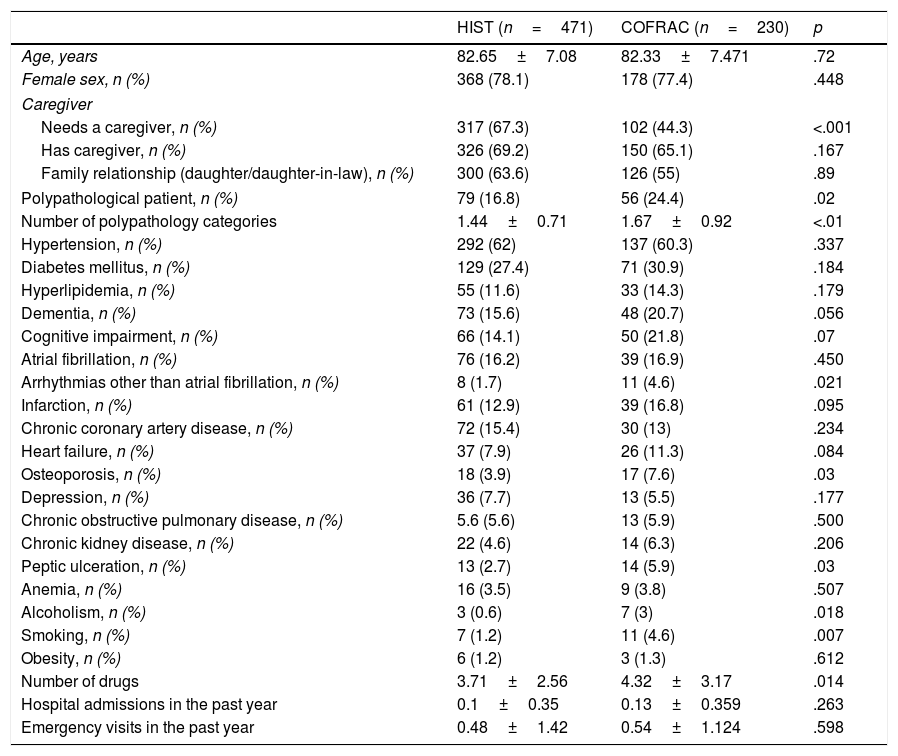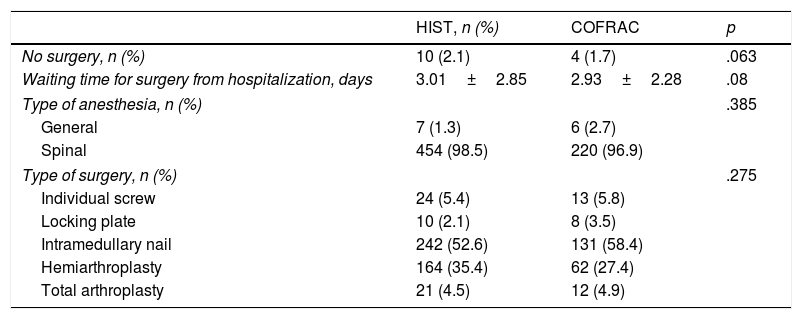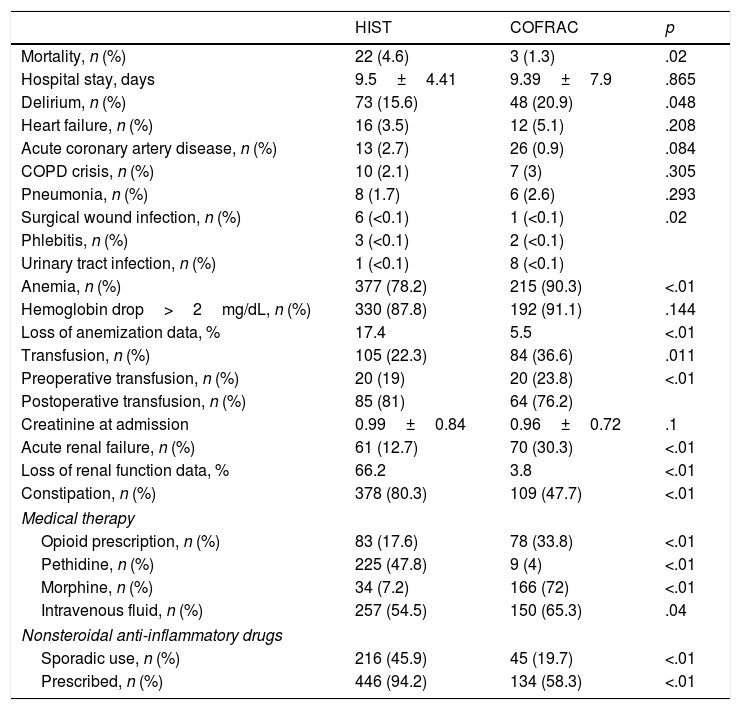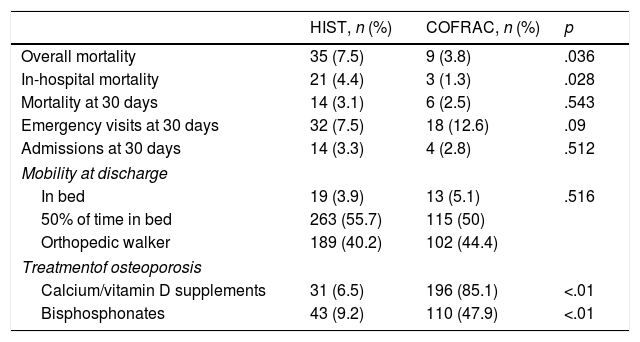Hip fracture in the elderly is one of the most prevalent diagnoses in Orthopedic Surgery Departments. It has a great impact in medical, economic and social terms. Our objective is to analyze clinical impact of a co-management care model between orthopedic surgery and internal medicine departments for elderly patients admitted with hip fracture in a tertiary referral hospital.
Material and methodsRetrospective cohort study of patients older than 65 years old admitted with hip fracture between January 2005 and August 2006 (HIST cohort) without a co-management care model, and between January 2008 and August 2010 (COFRAC cohort) with a co-manEdadment care model. Analysis of demographic, clinical and surgery characteristics, complications incidence and mortality and re-admissions at 30 days was made.
ResultsA total of 701 patients were included (471 HIST, 230 COFRAC). There were no differences in sex, gender, time to surgery, type of anesthesia and surgery, length of stay, ambulation at discharge and 30-days emergency room consultation, readmissions or mortality at 30 days. There were differences in identification of polypatological patients (16.8 vs. 24.4%, P=0.02), presence of osteoporosis (3.9 vs. 7.6%, P=0.03), motor deficit (3.5 vs. 8.8%, P=0.03), number of chronic drugs (3.7±2.5 vs. 4.3±3.2, P<0.01), diagnosis of delirium (15.6 vs. 20.9%, P=0.048), constipation (80.3 vs. 74.7%, P<0.001), monitoring of anemia (83.3 vs. 97.1%, P>0.01) and renal failure at discharge (44.5 vs. 97.3%, P<0.01) and hospital mortality (4.6 vs. 1.3%, P=0.02).
ConclusionsCo-management for elderly patients admitted with hip fracture provides a better information about previously chronic conditions, a higher control of hospital complications and decreases hospital mortality.
La fractura de cadera del anciano es de los diagnósticos más prevalentes en los servicios de Traumatología, con gran impacto en términos clínicos, económicos y sociales. Nuestro objetivo es analizar el impacto clínico de un modelo de comanejo entre Traumatología y Medicina Interna para pacientes ancianos ingresados por fractura de cadera en un hospital de tercer nivel.
Material y métodosCohortes retrospectivas de pacientes mayores de 65 años ingresados por fractura de cadera entre enero de 2005 y agosto de 2006 (cohorte HIST) sin modelo de comanejo, y entre enero de 2008 y agosto de 2010 (cohorte COFRAC) con dicho modelo. Se analizaron características demográficas, clínicas y quirúrgicas, incidencia de complicaciones, mortalidad y reingreso a los 30 días.
ResultadosSe incluyó a 701 pacientes (471 HIST, 230 COFRAC). No hubo diferencias en edad, género, demora quirúrgica, tiempo y tipo de cirugía e intervención, estancia, deambulación al alta, consulta en urgencias ni reingreso o mortalidad a 30 días. Hubo diferencias en identificación de pluripatológicos (16,8 vs. 24,4%; p=0,02), osteoporosis (3,9 vs. 7,6%; p=0,03) o déficit motor (3,5 vs. 8,8%; p=0,03), fármacos del tratamiento (3,7±2,5 vs. 4,3±3,2; p<0,01), aparición de delirium (15,6 vs. 20,9%, p=0,048) e hipomotilidad intestinal (80,3 vs. 74,7%; p<0,001), seguimiento de anemia (83,3 vs. 97,1%; p>0,01) y de función renal (44,5 vs. 97,3%; p<0,01) y mortalidad intrahospitalaria (4,6 vs. 1,3%; p=0,02).
ConclusionesEl comanejo de pacientes ancianos ingresados por fractura de cadera permite mejorar la documentación de los problemas crónicos previos y el control de complicaciones hospitalarias y disminuye la mortalidad intrahospitalaria.
Article
Diríjase desde aquí a la web de la >>>FESEMI<<< e inicie sesión mediante el formulario que se encuentra en la barra superior, pulsando sobre el candado.

Una vez autentificado, en la misma web de FESEMI, en el menú superior, elija la opción deseada.

>>>FESEMI<<<










